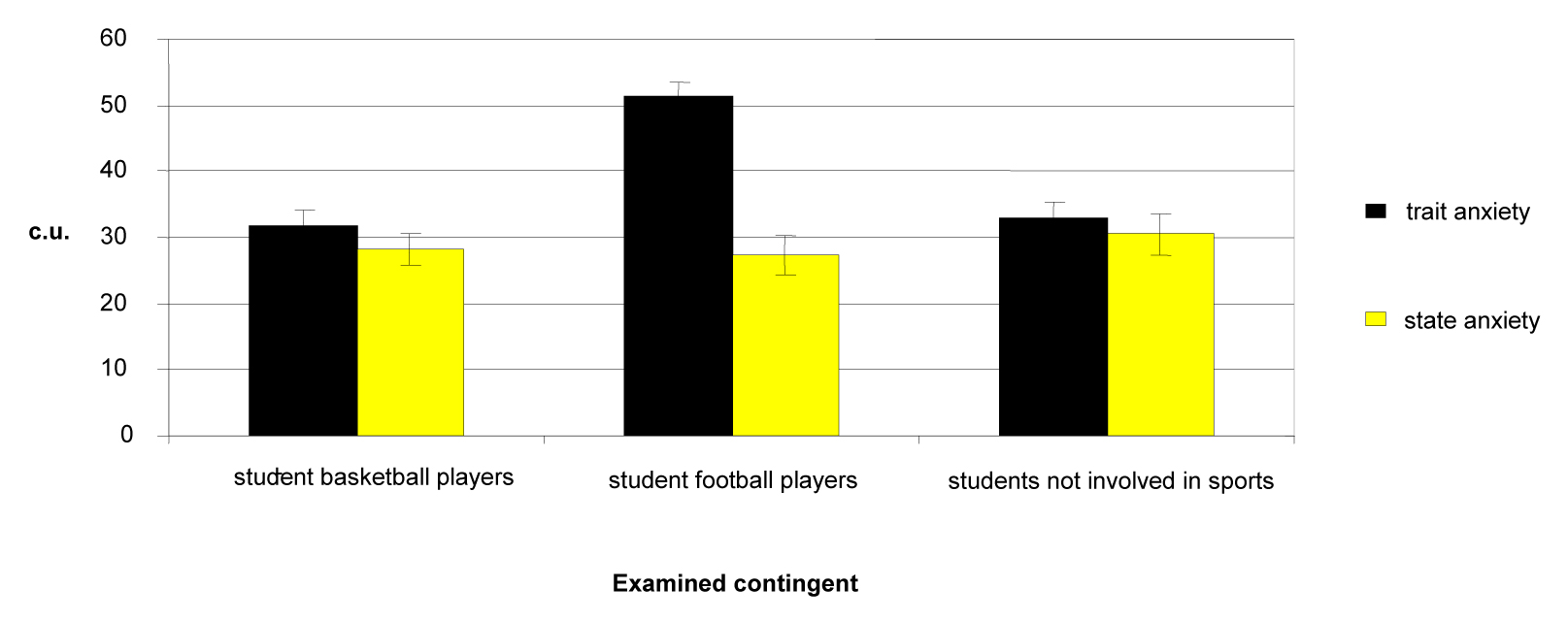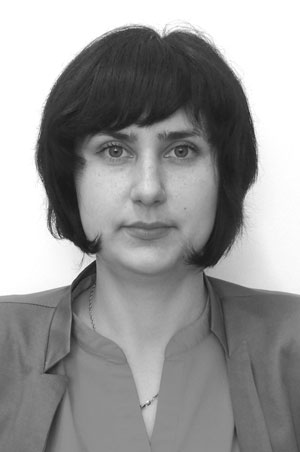Analysis of the Influence of Sports Classes within Section on Functional State of Nervous System of Students
Фотографии:
ˑ:
T.G. Petrova, Ph.D.
N.N. Khasanov, Ph.D.
S.S. Grechishkina, Ph.D.
A.A. Agirov, Dr.Med.
Adyghe State University, Maikop
Keywords: nervous system, neurophysiological status, student football players, student basketball players.
Introduction. Due to ever-complicating university educational programs and implementation of computer technologies lead to intensification of educational process and, definitely, the requirements to the body state of students are raised. It is known that during the academic year the central nervous system (WYC) of a student is under extreme loads [1, 2]. The main reason for this is chronic stress resulting from big information loads in highly stressful conditions and at constant time shortage [4, 9]. Motor activity is one of the essential conditions for the formation and improvement of the mechanisms of adaptation, including mental workloads. The current educational process in higher education does not fully compensate for the total deficit of physical activity, so mass sports classes are getting especially important under these conditions. Depending on the rational use physical activity can act as a facilitative or as a deadapting factor [2, 6]. So one should clarify the effect from classes in sport sections on the functional state of the central nervous system (CNS), as success in performance of both motor and educational activities is determined first of all by its current functional state [2].
The purpose of the study was to investigate the influence of sports load on the functional state of the nervous system of the students playing football and basketball in sport sections.
Materials and methods. The study was conducted in a cross-section mode with students of non-sports departments, who were regularly engaged in sport sections at the premises of the department of physical education of the Federal State Budgetary Educational Institution of Higher Professional Education “Adyghe State University”. The experimental group consisted of young male football (25) and basketball (20) players, the control group – of 35 2-4-year students of the Faculty of Natural Sciences of Adyghe State University training in the conventional motor mode (two physical education classes a week).
There were studied the indicators of simple visual-motor reaction (SVMR), tapping test, which represent variants of the conventional methods of chronoreflexometry, characterize overall tone, lability, mobility, power of the CNS and are among the most common indicators in testing of reaction rate and power of the nervous system. In addition, the parameters of reaction to a moving object (RMO) and critical flicker fusion frequency (CFFF) were determined, which helped evaluate the speed and precision in visual perception and functional state of the visual analyzer. Psycho-emotional state was estimated using Spielberg-Hanin test and the method of static tremometry.
The research findings were statistically processed on the PC using the statistical package Statistica 6.0 and the built-in function of analysis in the Microsoft Excel (2007) software.
Results and discussion. One of the objective criteria of the functional status of the CNS is the time of SVMR, which characterizes the lead time of the processes of inhibition and excitation of the CNS, the capacity for differentiating inhibition and precision of the performed work. The time of SVMR characterizes the temporal indices of nervous processes, which are the basic ones in human psychomotor activity [3].
As seen from the study, the time of SVMR was significantly shorter in students engaged in basketball sections rather than in those engaged in football sections or students not doing in sports.
The analysis of the SVMR indices of student basketball and football players proves that basketball classes, where the most favorable conditions for the development of the speed quality are created, which is stipulated by the specifics of the training activity requiring fast alteration of motor programs, high level of attention, and high sensitivity of the wrist motor analyzer compared with student football players [5]. However, a decrease in the volume and intensity of training load during section classes is good for the development of the speed quality during basketball classes, and during football classes - in terms of high motor density. On the background of fatigue cumulation the differences in the SVMR indices were less pronounced in students not doing sports (р>0.05).
While determining the power of the nervous system using the tapping test it was found that an average type of nervous system prevailed in student basketball players, as well as in non-athletes, since their tapping rate equaled 7.2±0.6 and 7.1±0.5 Hz (р>0.05) respectively. Weak nervous system prevailed in students doing sports in football sections, whose tapping rate was equal to 6.4±0.4 Hz.
The analysis of the CFFF results showed that football players had the lowest indices here - 39.5±1.9 Hz, which is indicative of the low lability of the nervous system, do they could not always properly react to the information given at a quick rate, or adequately choose the tactics of movements on a playing ground under time pressure. Probably, physical loads imposed on the examined contingent of football players exceeded the functional capacities of their bodies due to the lack of academic hours allowed for fitness training within sections. It is a known fact that if during football training power and speed-strength exercises of high intensity and high motor density are adequately used, the overall level of functioning of the nervous system significantly increases [4].
The highest CFFF values, which testify to the prevalence of the contingent prone to the high lability of the nervous system, were registered in basketball players (41.1±0.9 Hz, р<0.05). This means that students doing sports in basketball sections had high speed and precision in visual perception and high capacity for differentiated reactions to sensory stimuli compared with football players.
The lowest CFFF values were registered in students not involved in sports (37.4±1.4 Hz). Student football players had lower values compared to basketball players, which, as some authors believe, may be indicative of the development of inhibition processes, a decrease in the level of lability of nervous centers on the background of the developing fatigue in terms of hyperkinesia [5].
Reaction to a moving object was used to estimate the balance of nervous processes in students doing sports in sections. Development of the optimal reaction to a moving object is important not only in combat sports, but also in team sports, as thus the possible trajectory of the ball, teammates or opponents on playing ground can be predicted, and the preparation of athletes' counteractions is speeded up. Athletes with balanced nervous processes act more effectively on playing ground, and consequently, they are under lower psycho-emotional stress.
Among student basketball players those with accurate reactions amounted to 40.0% of the total of the examined students, while anticipation strategy was used by 25.0%, and delay strategy - by 35.0% of the subjects. Among student football players, reactions of anticipation were registered in 40.0%, reactions of delay - in 48.0% and only 12.0% had accurate reactions. According to the study of the balance of nervous processes based on the RMO indices, 37.2% of the students from the control group used reactions of anticipation, 54.2% - reactions of delay and only 8.6% reacted to the stimulus accurately (Fig. 1). As seen from the comparative analysis, the number of those with accurate reactions and optimal balance of nervous processes is the highest among student basketball players. This is particularly important for athletes engaged in team sports, who constantly find themselves in situations of quick reactions to ever-changing conditions, the complication of which is determined by multiple alternative choices and strictly limited time allowed for decision making.
The existence of those with reactions of anticipation proves that anxiety prevails, and with reactions of delay - testifies that the body gets involved into work gradually, but at the same time that stipulates a relatively long-term optimal working capacity. This has been described earlier by E.P. Il'in in his studies [5]. The balance of nervous processes towards inhibition conditions emotional restraint, lack of internal motivation to active actions, and, on the contrary, prevalence of anxiety determines extremely impulsive behavioral reactions and unstable sport results.

Fig. 1. Indices of reactions to a moving object in students not involved in sports and those engaged in sport sections
While analyzing the dynamics of the static tremometry indices, we found that the registered number of touches performed by student basketball players amounted to 25.6±1.9 per second, and the time of touches - 2.4±1.4 ms. Maximum number of touches (30.2±1.9 per second, the time of touches – 2.9±1.7 ms), which is evidence of psycho-emotional stress and instability of the neuromuscular apparatus, was registered in student football players. The number of touches performed by students not involved in sports equaled 31.2±1.7 per second, and the time of touches – 2.94±1.7 ms.
The analysis of the Spielberg-Hanin test results of the examined student basketball and football players revealed that the level of trait anxiety in football players was significantly higher than in the rest of the examined groups (51.3±2.1 c.u. versus 31.8±2.5 c.u. in basketball players and 33.1 c.u. in students not involved in sports, р<0.01) (Fig. 2). State anxiety in student basketball and football players was at a low level and had no significant differences (28.3±2.4 and 27.4±3.0 c.u. respectively).

Fig. 2. Results of the Spielberg-Hanin anxiety test of students not involved in sports and those engaged in sport sections
Students not involved in sports had an average level of trait anxiety. V. Balyuk [3] assumes that the lowest indices of the anxiety level in underskilled athletes are a result of the reduced sport motivation, absence of prospects for the further improvement of sports skills and lack of competitive stress.
Conclusions. The differences in the basic neurophysiological indices of the functional state of the nervous system of students depending on the sport specialization have been established: among student basketball players compared to football players and non-athletes those (40%) with an average type of the nervous system, high (35%) and average (40 %) levels of functional mobility of nervous processes, accurate and fast reactions to a moving object dominated. The overwhelming majority of student football players (64%) had a weak nervous system on the background of the prevalence of those with inert nervous processes, delay in reactions to a moving object, a high level of anxiety, indicating maladjustment on the neurophysiological level, high psycho-emotional stress due to an inadequate training mode and can impede good sports performance, if action is not taken in good time to optimize the training load.
References
- Aghajanyan, N.A. Quality and lifestyle of young students / N.A. Aghajanyan, I.V. Radysh // Ekologiya cheloveka. – 2009. – № 5. – P. 3–8. (In Russian)
- Akhmedova, O.O. Psychophysiological state of first-year students with different levels of physical activity / O.O. Akhmedova, G.O. Ovezgel'dyeva, A.G. Grigor'yan // Fiziologiya cheloveka. – 2011. – P. 37. – № 5. – P. 84–90. (In Russian)
- Balyuk, V.G. The relationship and importance of the basic neurodynamic characteristics of athletes of different specializations and qualifications: abstract of Ph.D. thesis / V.G. Balyuk. - Arkhangelsk, 2009. – 20 P. (In Russian)
- Grechishkina, S.S. Integrated analysis of the functional state of the cardiovascular system of students who train in a football sports section / S.S. Grechishkina, M.N. Silant'ev, E.A. Ivantsov // Teoriya i praktika fizicheskoy kul'tury. – 2013. – № 8. – P. 56–61. (In Russian)
- Il'in, E.P. Sport Psychology / E.P. Il'in. – St. Petersburg: Piter, 2010. – 352 P. (In Russian)
Corresponding author: zabolotniy-tol1@yandex.ru


